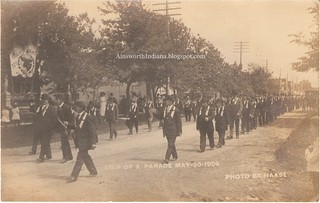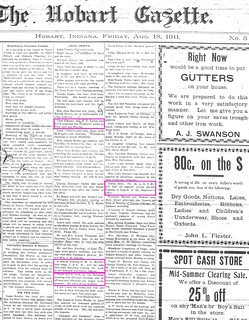
(Click on image to enlarge)
I bought this postcard on eBay. When I received it in the mail, my first thought was, "Oops, I did it again, I bought something useless on eBay." A little reflection made me realize that it isn't useless, because it introduces a topic I should give some attention to, namely: fraternal organizations.
Pictured above is Court Hobart No. 3 of the Independent Order of Foresters of America, on parade (in a location I can't identify*) on May 30, 1909, probably in honor of Decoration Day. What strikes me most about this image is the number of men marching. I'm looking down the two lines for another flag or something to mark the end of this group, and I'm not seeing it. They seem to take the whole matter quite seriously, these marching men, bearing the flag of their organization, dressed in their best suits adorned with regalia. (And notice the boy at the right edge of the photo, who appears to be standing at attention with his hand over his heart.)
And the I.O.F. of A. was just one of several fraternal organizations in Hobart.

The Hobart News routinely printed notices like this one, from February 11, 1915, of regularly scheduled meetings among Hobart's various fraternal organizations. (The I.O.O.F. was the Independent Order of Odd Fellows, the Rebekahs its female auxiliary; M.w. of A. — Modern Woodmen of America; F. and A.M. — Free and Accepted Masons.) That notice does not mention a few others I know of — the Ladies of the Maccabees (L.O.T.M.); Order of the Eastern Star (O.E.S.); and Fraternal Order of Rangers.
Selected at random, this front page shows a fairly typical level of fraternal-society-related news items:

(Click on image to enlarge)
In September the Masons' special meeting was for work in the Entered Apprentice degree. That month's news was a little less typical in that some fifteen Hobart Odd Fellows went to Indianapolis to attend the Grand Sovereign Lodge encampment.
We've already seen the exterior of the Masons' handsome temple, built in 1925 and still in use; here is an interior view, probably shortly after it was built:

(Click on image to enlarge)
Image courtesy of the Hobart Historical Society.
The Odd Fellows had their own meeting-place, known as Odd Fellows Hall, but I don't know where it was, nor have I seen a picture of it.
I know offhand of a several Ainsworth people with lodge memberships — Ed Sauter was a Mason, Charles Chester an Odd Fellow, and Charles Nelson must have been a Forester, since Lovisa collected insurance money from that organization after his death.
The death of any member was usually followed by the publishing of a memorial resolution. For example, after Cornelius Carstensen's death in November 1911 he was memorialized by both of the organizations to which he belonged:

(Click on image to enlarge)
Since no one among my own family or friends has ever belonged to a fraternal organization (unless you consider a volunteer fire department to be one), I have very little knowledge of any details of fraternal life: how a typical meeting proceeded, what the initiation ritual involved, what "work" was required to earn a degree, and so forth. I have a vague general impression of secrecy, mysticism and idealism — well illustrated, I think, by this 1964 letter to the Hobart Odd Fellows, containing coded passwords and "explanation" that expressed lofty sentiments and were painstakingly deciphered by the recipient:

(Click on image to enlarge)
Image courtesy of the Hobart Historical Society.
In this age of the internet, when you expect to be able to educate yourself on any esoteric topic by careful use of search terms, gritty details concerning early-20th-century fraternities are surprisingly hard to come by. Thus far the best source I've found is an on-line "fraternal history" of Marin County, California.
And as for hard statistics on exactly how many Hobartites were members of such organizations, I haven't got them and don't expect I ever will unless they providentially fall into my lap, since that is really beyond the scope of my research. All I can do is state my general impressions. And it does seem to me that these organizations — with their ritual and regalia, their regular meetings and occasional parades, and their lofty idealism (though it may perhaps have been more honored in word than deed) — were an important presence in the lives of the people we've been getting to know here, affecting their thoughts and their behavior in a way that we modern non-joining, non-meeting types may find hard to understand.
________________________
*[8/1/2011 update] Further research leads me to believe that this postcard shows the intersection of Main and Front Streets. The house in the background at left may be the Jarvis Roper house on the southeast corner of that intersection; the white frame building just visible behind the trees is probably the first St. Bridget's Church.
Sources:
♦ "General News Items." Hobart Gazette 6 Apr. 1906.
♦ Indiana WPA Death Records Index.
♦ "Local Drifts." Hobart Gazette 18 Aug. 1911; 8 Sept. 1911; 22 Sept. 1911; 29 Sept. 1911; 1 Dec. 1911.
♦ "Lodge Notices." Hobart News 11 Feb. 1915.
♦ "Personal and Local Mention." Hobart News 26 Dec. 1912.
♦ "Resolutions of Condolence." Hobart Gazette 15 Dec. 1911.
♦ "Resolutions." Hobart Gazette 15 Dec. 1911.


No comments:
Post a Comment